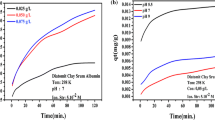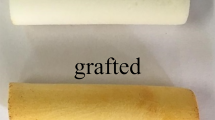Abstract
Cibacron Blue 3GA was immobilized on Sepharose CL-6B to obtain a highly substituted dye-ligand adsorbent which dye concentration was 17.4 μmol dye per gram wet gel. This adsorbent had a highly binding capacity for bovine serum albumin (BSA). The effects of ionic strength on the adsorption and desorption of BSA to the adsorbent were studied. Adsorption isotherms were expressed by the Langmuir model. The quantitative relationships between the model parameters and the ionic strength were obtained. The desorptions were performed by adding salt to the BSA solutions in which adsorption equilibria had been reached. Adding salt to the solution resulted in the desorption of the bound protein. It was found that the isotherm obtained from the desorption experiments agreed well to the isotherm obtained from the adsorption experiments at the same ionic strength. The result demonstrated that the adsorption of BSA to the highly substituted adsorbent was reversible.
Similar content being viewed by others
Author information
Authors and Affiliations
Additional information
Received: 16 December 1996
Rights and permissions
About this article
Cite this article
He, LZ., Gan, YR. & Sun, Y. Adsorption-desorption of BSA to highly substituted dye-ligand adsorbent: quantitative study of the effect of ionic strength. Bioprocess Engineering 17, 301–305 (1997). https://doi.org/10.1007/s004490050389
Issue Date:
DOI: https://doi.org/10.1007/s004490050389




